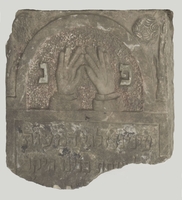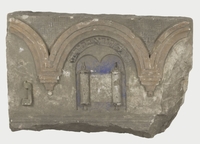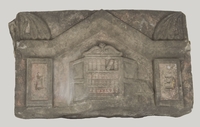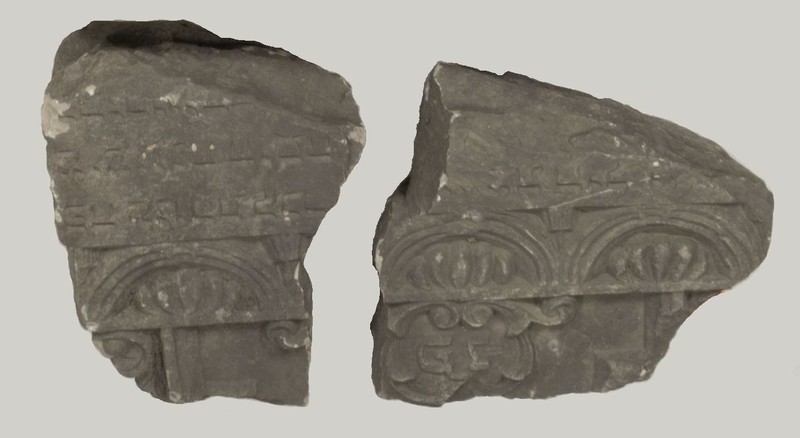Overview
- Brief Narrative
- Broken headstone carved with a pair of hands symbolizing the tribe Kohen recovered during a 1989 renovation of a building in Konin county, Poland. The tombstones, from the desecrated Turek Jewish cemetery, were broken and used as paving stones for the courtyard of the local headquarters for Organization Todt. This sandstone marker was mass produced in the late 19th century. Poland was invaded and occupied by Nazi Germany in September 1939. Hundreds of Jewish men from Turek were taken as forced laborers. By January, all Jewish property was confiscated and the remaining Jews were confined to a ghetto. The synagogue was set on fire and destroyed. In October 1941, the ghetto was liquidated and Turek was Judenfrei (free of Jews.) Organization Todt was in charge of road and large scale construction projects, such as factories and fortifications, for the German Reich. By the early 1940s, it controlled over a million workers, slave laborers, war prisoners, and camp inmates.
- Date
-
creation:
approximately 1850-1899
recovered: 1989
use: after 1939 September
- Geography
-
use:
Jewish cemetery;
Turek (Poland)
use: Organization Todt local headquarters; Konin (Poland : Powiat)
- Credit Line
- United States Holocaust Memorial Museum Collection, Gift of the Muzeum Okręgowe w Koninie
Physical Details
- Language
- Hebrew
- Classification
-
Jewish Art and Symbolism
- Category
-
Jewish ceremonial objects
- Object Type
-
Jewish sepulchral monuments (lcsh)
- Physical Description
- Two broken sections of the same tombstone:
a. Broken, small, left side section of a gray sandstone grave marker with 3 carved rows: at the top are 2 Hebrew characters pen and nun [for po nikbar : Here Lies], within an open scrollwork circle; below a narrow bar, then 2 semi-circular, ridged banners enclosing 5 oval beads; the third section has 1 line of Hebrew text. The stone is nearly straight across the top and broken at angles, but fairly smooth, on the other three sides. The right side of this stone appears to fit into the left side of stone b.
b. Broken, small, right side section of a gray sandstone grave marker with 3 carved rows: at the top are 2 panels separated by a vertical bar; the left smooth, the right with a small section of scrollwork; a horizontal bar, then a semi-circular, ridged banner enclosing 5 oval beads; and then 3 lines of Hebrew text. The stone is straight along the top and right side, and broken, with fairly smooth edges on the bottom and left. - Dimensions
- a: Height: 12.500 inches (31.75 cm) | Width: 9.250 inches (23.495 cm) | Depth: 3.625 inches (9.208 cm)
b: Height: 10.875 inches (27.623 cm) | Width: 11.750 inches (29.845 cm) | Depth: 3.500 inches (8.89 cm) - Materials
- a : sandstone
b : sandstone - Inscription
- a. front, engraved : Hebrew text
b. front, engraved : Hebrew text
Rights & Restrictions
- Conditions on Access
- No restrictions on access
- Conditions on Use
- No restrictions on use
Keywords & Subjects
- Topical Term
- Holocaust, Jewish (1939-1945)--Poland--Turek. Jewish cemeteries--Desecration--Poland--Turek--History--20th century. Jewish cemeteries--Destruction and pillage--Poland--Turek. Offenses against religion--Poland--Turek--History--20th century. World War, 1939-1945--Cemeteries--Desecration--Poland--Turek. World War, 1939-1945--Cemeteries--Destruction and pillage--Poland--Greece.
- Geographic Name
- Poland--History--Occupation, 1939-1945.
Administrative Notes
- Legal Status
- Permanent Collection
- Provenance
- The tombstone fragment was donated to the United States Holocaust Memorial Museum in 1990 by the Muzeum Okregowego W Koninie.
- Funding Note
- The cataloging of this artifact has been supported by a grant from the Conference on Jewish Material Claims Against Germany.
- Record last modified:
- 2022-07-28 18:21:24
- This page:
- https://collections.ushmm.org/search/catalog/irn3510
Download & Licensing
In-Person Research
- By Appointment
- Request 21 Days in Advance of Visit
- Plan a Research Visit
- Request to See This Object
Contact Us
Also in Muzeum Okregowego W Koninie collection
The collection consists of two paintings from the Kolo synagogue and six tombstone fragments from the Turek Jewish cemetary.

Desecrated, broken tombstone with carved hands symbol from Turek Jewish cemetery
Object
Broken headstone carved with a pair of hands with split fingers, symbol of Kohen, or priest and the gesture of blessing, recovered during a 1989 renovation of a building in Konin county, Poland. The tombstones, from the desecrated Turek Jewish cemetery, were broken and used as paving stones for the courtyard of the local headquarters for Organization Todt. This sandstone marker was mass produced in the late 19th century. Poland was invaded and occupied by Nazi Germany in September 1939. Hundreds of Jewish men from Turek were taken as forced laborers. By January, all Jewish property was confiscated and the remaining Jews were confined to a ghetto. The synagogue was set on fire and destroyed. In October 1941, the ghetto was liquidated and Turek was Judenfrei (free of Jews.) Organization Todt was in charge of road and large scale construction projects, such as factories and fortifications, for the German Reich. By the early 1940s, it controlled over a million workers, slave laborers, war prisoners, and camp inmates.

Desecrated, broken tombstone with carved crown from Turek Jewish cemetery
Object
Broken headstone carved with a crown recovered during a 1989 renovation of a building in Konin county, Poland. The tombstones, from the desecrated Turek Jewish cemetery, were broken and used as paving stones for the courtyard of the local headquarters for Organization Todt. This sandstone marker was mass produced in the late 19th century. Poland was invaded and occupied by Nazi Germany in September 1939. Hundreds of Jewish men from Turek were taken as forced laborers. By January, all Jewish property was confiscated and the remaining Jews were confined to a ghetto. The synagogue was set on fire and destroyed. In October 1941, the ghetto was liquidated and Turek was Judenfrei (free of Jews.) Organization Todt was in charge of road and large scale construction projects, such as factories and fortifications, for the German Reich. By the early 1940s, it controlled over a million workers, slave laborers, war prisoners, and camp inmates.

Desecrated, broken tombstone with carved candelabra from Turek Jewish cemetery
Object
Broken headstone carved with a candelabra with candles, traditionally used to mark a woman's grave, recovered during a 1989 renovation of a building in Konin county, Poland. The tombstones, from the desecrated Turek Jewish cemetery, were broken and used as paving stones for the courtyard of the local headquarters for Organization Todt. This sandstone marker was mass produced in the late 19th century. Poland was invaded and occupied by Nazi Germany in September 1939. Hundreds of Jewish men from Turek were taken as forced laborers. By January, all Jewish property was confiscated and the remaining Jews were confined to a ghetto. The synagogue was set on fire and destroyed. In October 1941, the ghetto was liquidated and Turek was Judenfrei (free of Jews.) Organization Todt was in charge of road and large scale construction projects, such as factories and fortifications, for the German Reich. By the early 1940s, it controlled over a million workers, slave laborers, war prisoners, and camp inmates.

Desecrated, broken tombstone with carved Torah scroll from Turek Jewish cemetery
Object
Broken headstone carved with a Torah scroll, indicating the grave of a reader of the Torah, Kohen recovered during a 1989 renovation of a building in Konin county, Poland. The tombstones, from the desecrated Turek Jewish cemetery, were broken and used as paving stones for the courtyard of the local headquarters for Organization Todt. This sandstone marker was mass produced in the late 19th century. Poland was invaded and occupied by Nazi Germany in September 1939. Hundreds of Jewish men from Turek were taken as forced laborers. By January, all Jewish property was confiscated and the remaining Jews were confined to a ghetto. The synagogue was set on fire and destroyed. In October 1941, the ghetto was liquidated and Turek was Judenfrei (free of Jews.) Organization Todt was in charge of road and large scale construction projects, such as factories and fortifications, for the German Reich. By the early 1940s, it controlled over a million workers, slave laborers, war prisoners, and camp inmates.

Desecrated, broken tombstone with carved bookshelf from Turek Jewish cemetery
Object
Broken headstone carved with a bookshelf filled with books, indicating the final resting place of a scholar, recovered during a 1989 renovation of a building in Konin county, Poland. The tombstones, from the desecrated Turek Jewish cemetery, were broken and used as paving stones for the courtyard of the local headquarters for Organization Todt. This sandstone marker was mass produced in the late 19th century. Poland was invaded and occupied by Nazi Germany in September 1939. Hundreds of Jewish men from Turek were taken as forced laborers. By January, all Jewish property was confiscated and the remaining Jews were confined to a ghetto. The synagogue was set on fire and destroyed. In October 1941, the ghetto was liquidated and Turek was Judenfrei (free of Jews.) Organization Todt was in charge of road and large scale construction projects, such as factories and fortifications, for the German Reich. By the early 1940s, it controlled over a million workers, slave laborers, war prisoners, and camp inmates.




